Stress Reduction Exercises: A Guide to Well-being
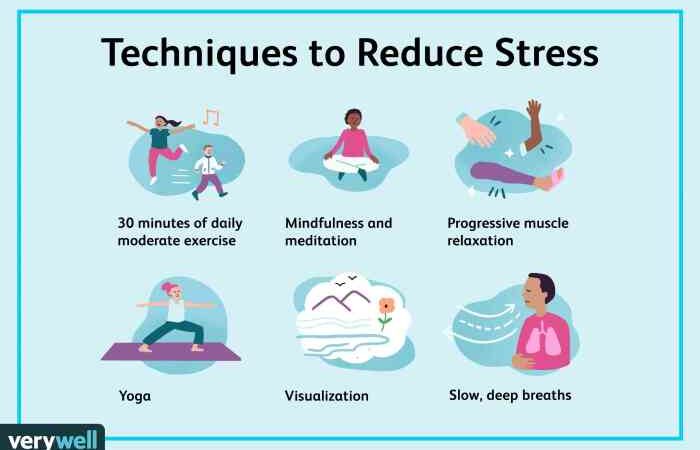
Stress reduction exercises offer a powerful path to improved mental and physical health. These techniques, ranging from physical practices like yoga and tai chi to mental exercises like mindfulness and deep breathing, empower individuals to manage stress effectively and cultivate a sense of inner peace.
By understanding the science behind these exercises and incorporating them into daily routines, individuals can experience a myriad of benefits, including reduced anxiety, enhanced focus, improved sleep quality, and increased resilience to life’s challenges.
Introduction to Stress Reduction Exercises
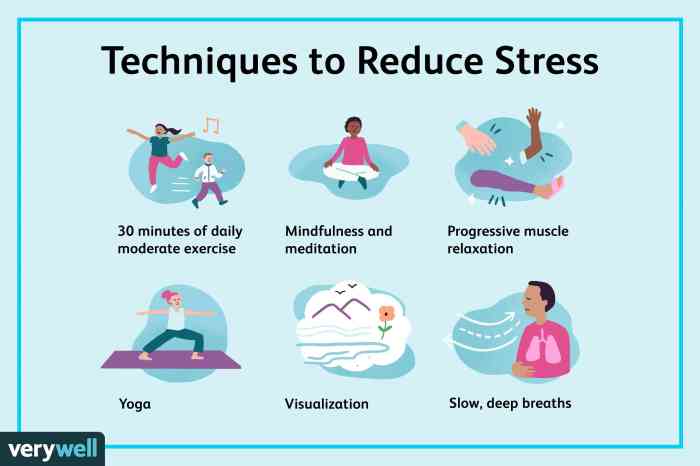
Stress reduction exercises are techniques and activities designed to help individuals manage and reduce stress levels. They aim to promote relaxation, improve mood, and enhance overall well-being. Incorporating these exercises into daily life can significantly contribute to a healthier and more balanced lifestyle.
The Impact of Stress on Physical and Mental Well-being
Stress is a natural response to challenging situations. However, chronic stress can have detrimental effects on both physical and mental health. Prolonged exposure to stress can lead to various health issues, including:
- Increased risk of heart disease, stroke, and high blood pressure
- Weakened immune system, making individuals more susceptible to illnesses
- Digestive problems, such as irritable bowel syndrome
- Sleep disturbances, including insomnia and difficulty falling asleep
- Mental health issues, such as anxiety, depression, and burnout
Stress can also negatively impact mental well-being, leading to feelings of overwhelm, irritability, difficulty concentrating, and impaired decision-making. It can also contribute to social isolation and strained relationships.
Benefits of Stress Reduction Exercises
Stress reduction exercises offer numerous benefits for both physical and mental health. These benefits include:
- Reduced anxiety and stress levels
- Improved mood and overall well-being
- Enhanced sleep quality
- Increased energy levels
- Improved focus and concentration
- Strengthened immune system
- Reduced risk of chronic diseases
- Improved relationships and social interactions
By incorporating stress reduction exercises into daily life, individuals can effectively manage stress levels, improve their overall health, and lead more fulfilling lives.
Types of Stress Reduction Exercises
Stress reduction exercises are designed to help individuals manage and reduce stress levels. These exercises can be categorized into different types, each focusing on different aspects of well-being and offering unique approaches to stress management.
Physical Exercises
Physical exercises are known to have a positive impact on both physical and mental health. They can help release endorphins, reduce muscle tension, and improve sleep quality, all of which contribute to stress reduction.
- Yoga: This ancient practice involves a series of postures, breathing techniques, and meditation. Yoga helps to improve flexibility, balance, and strength while promoting relaxation and reducing stress.
- Tai Chi: A gentle form of exercise that involves slow, flowing movements and deep breathing.Tai Chi can help to improve balance, coordination, and focus while reducing stress and anxiety.
- Aerobic Exercise: Activities like running, swimming, cycling, or dancing that elevate heart rate and improve cardiovascular health. Aerobic exercise releases endorphins and reduces stress hormones, leading to a sense of well-being.
Mental Exercises
Mental exercises aim to calm the mind, improve focus, and promote relaxation. These exercises can be practiced anywhere and anytime, making them readily accessible for stress management.
- Mindfulness: This practice involves paying attention to the present moment without judgment. Mindfulness helps to reduce overthinking and worry, promoting a sense of calm and awareness.
- Deep Breathing: Simple yet effective technique that involves taking slow, deep breaths to calm the nervous system.Deep breathing can reduce heart rate, lower blood pressure, and promote relaxation.
- Progressive Muscle Relaxation: This technique involves systematically tensing and relaxing different muscle groups in the body. Progressive muscle relaxation helps to release physical tension and promote a sense of calm.
Social Exercises
Social connections play a crucial role in overall well-being and stress management. Engaging in social activities can help to reduce feelings of loneliness, isolation, and stress.
- Spending Time with Loved Ones: Connecting with family and friends can provide emotional support, reduce stress, and promote a sense of belonging.
- Engaging in Hobbies: Pursuing hobbies and interests can provide a sense of purpose, accomplishment, and enjoyment, reducing stress and promoting relaxation.
- Joining Social Groups: Participating in social groups or clubs can provide opportunities for interaction, shared experiences, and support, reducing feelings of isolation and stress.
The Science Behind Stress Reduction Exercises
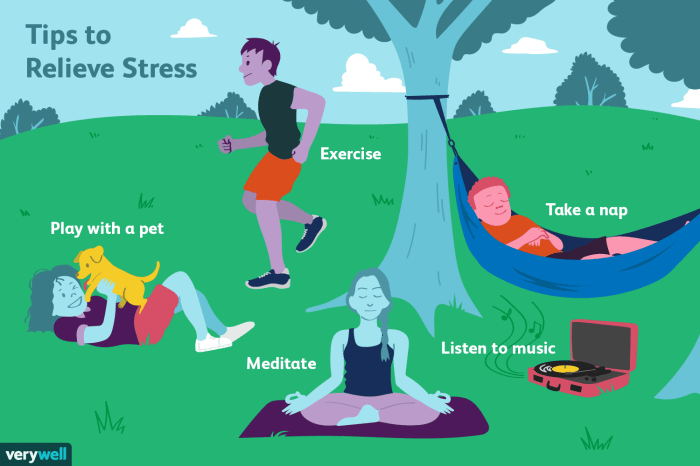
Stress reduction exercises are not just a fad; they are backed by a robust body of scientific evidence that demonstrates their effectiveness in reducing stress and promoting well-being. These exercises work by influencing various physiological and psychological mechanisms, leading to a cascade of positive effects on the body and mind.
The Impact on the Nervous System
Stress reduction exercises, particularly those involving deep breathing, meditation, and mindfulness, exert a profound influence on the nervous system. They activate the parasympathetic nervous system, which is responsible for the “rest and digest” response, counteracting the effects of the sympathetic nervous system, which is activated during stress.
- Reduced Sympathetic Activity: Stress reduction exercises help lower the activity of the sympathetic nervous system, leading to a decrease in the release of stress hormones like adrenaline and cortisol. This reduction in sympathetic activity slows down the heart rate, lowers blood pressure, and reduces muscle tension, all of which are hallmarks of the stress response.
- Increased Parasympathetic Activity: Simultaneously, these exercises stimulate the parasympathetic nervous system, promoting relaxation and a sense of calm. This activation triggers the release of acetylcholine, a neurotransmitter that helps regulate the heart rate, breathing, and digestion, promoting a state of physiological balance.
The Influence on Hormone Levels
Stress reduction exercises play a crucial role in regulating hormone levels, particularly those associated with the stress response.
- Lowered Cortisol Levels: Cortisol, the primary stress hormone, is released in response to stressful situations. Stress reduction exercises have been shown to reduce cortisol levels, promoting a sense of calmness and reducing the negative effects of prolonged stress on the body.
- Increased Endorphin Production: Endorphins are natural painkillers and mood elevators produced by the brain. Stress reduction exercises, such as yoga and exercise, can stimulate endorphin release, leading to a sense of well-being and reducing pain perception.
The Effect on Brain Activity, Stress Reduction Exercises
Stress reduction exercises have a profound impact on brain activity, promoting relaxation and improving cognitive function.
- Reduced Activity in the Amygdala: The amygdala is the part of the brain responsible for processing fear and emotional responses. Stress reduction exercises have been shown to reduce activity in the amygdala, helping to mitigate the negative effects of stress on emotional regulation.
- Increased Activity in the Prefrontal Cortex: The prefrontal cortex is involved in higher-level cognitive functions, including decision-making, planning, and working memory. Stress reduction exercises have been shown to increase activity in the prefrontal cortex, leading to improved focus, concentration, and emotional regulation.
Scientific Evidence Supporting the Effectiveness
Numerous scientific studies have provided compelling evidence supporting the effectiveness of stress reduction exercises.
- Meta-analysis of Meditation: A meta-analysis of 47 studies involving over 3,500 participants found that meditation practices significantly reduced stress, anxiety, and depression, and improved overall well-being.
- Yoga for Stress Management: A study published in the Journal of Alternative and Complementary Medicine found that yoga was effective in reducing stress, anxiety, and depression in individuals with chronic stress.
- Mindfulness-Based Stress Reduction (MBSR): MBSR is a structured program that combines mindfulness meditation, yoga, and body awareness practices. Studies have demonstrated its effectiveness in reducing stress, improving sleep quality, and enhancing emotional well-being.
Creating a Stress Reduction Exercise Routine
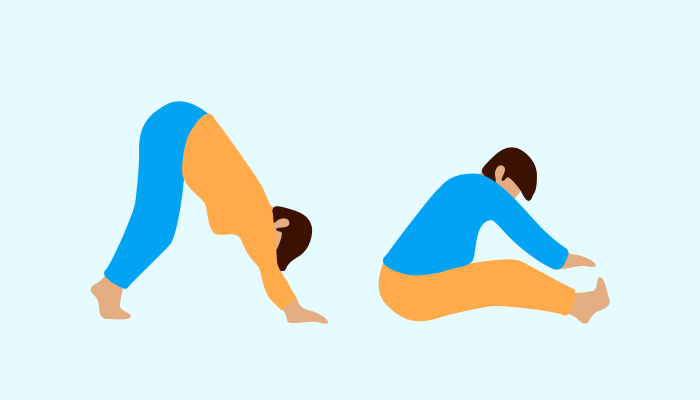
Designing a personalized stress reduction exercise routine can significantly enhance your well-being. By incorporating various techniques, you can effectively manage stress and promote relaxation.
Sample Stress Reduction Exercise Routine
A sample stress reduction exercise routine can be structured as follows:
Warm-up Exercises
Warm-up exercises prepare your body and mind for the main exercises. These exercises can help you transition into a relaxed state and focus your attention.
- Deep Breathing: Take slow, deep breaths, inhaling through your nose and exhaling through your mouth. Focus on the sensation of your breath and allow your body to relax.
- Progressive Muscle Relaxation: Tense and release different muscle groups in your body, starting with your toes and working your way up to your head. This helps to release tension and promote relaxation.
- Gentle Stretching: Perform light stretches, such as arm circles, leg swings, or neck rolls, to improve blood circulation and flexibility.
Main Exercises
The main exercises are the core of your stress reduction routine. These exercises are designed to promote relaxation, reduce stress hormones, and improve your overall well-being.
- Mindfulness Meditation: Sit comfortably in a quiet place, close your eyes, and focus on your breath or a specific object. Observe your thoughts and feelings without judgment, allowing them to pass without getting carried away.
- Yoga: Yoga combines physical postures, breathing techniques, and meditation to promote relaxation and stress reduction. There are various styles of yoga to choose from, such as Hatha yoga or Yin yoga.
- Tai Chi: This ancient Chinese practice involves slow, gentle movements and deep breathing. It helps to improve balance, coordination, and mental clarity.
- Guided Imagery: Imagine yourself in a peaceful and relaxing environment, such as a beach or a forest. Visualize the sights, sounds, and sensations of this place, allowing your mind to relax and de-stress.
Cool-down Exercises
Cool-down exercises help you gradually transition out of the relaxed state and return to your daily activities. These exercises can promote a sense of calm and well-being.
- Deep Breathing: Continue with deep, slow breaths, focusing on your breath and allowing your body to relax.
- Gentle Stretching: Perform light stretches, such as arm circles or neck rolls, to improve blood circulation and flexibility.
- Mindful Walking: Take a slow, mindful walk, paying attention to the sensations of your feet on the ground and the surroundings. This helps to ground you and promote a sense of calm.
Adapting the Routine to Individual Needs and Preferences
It is essential to adapt the stress reduction exercise routine to your individual needs and preferences. Consider the following tips:
- Time Commitment: Start with a shorter routine and gradually increase the duration as you become more comfortable.
- Exercise Preferences: Choose exercises that you enjoy and find relaxing. If you dislike meditation, try yoga or guided imagery instead.
- Physical Limitations: If you have any physical limitations, modify the exercises accordingly. Consult with a healthcare professional for guidance.
- Consistency: The key to success is consistency. Aim to practice your stress reduction routine regularly, even if it’s just for a few minutes each day.
Benefits and Applications of Stress Reduction Exercises
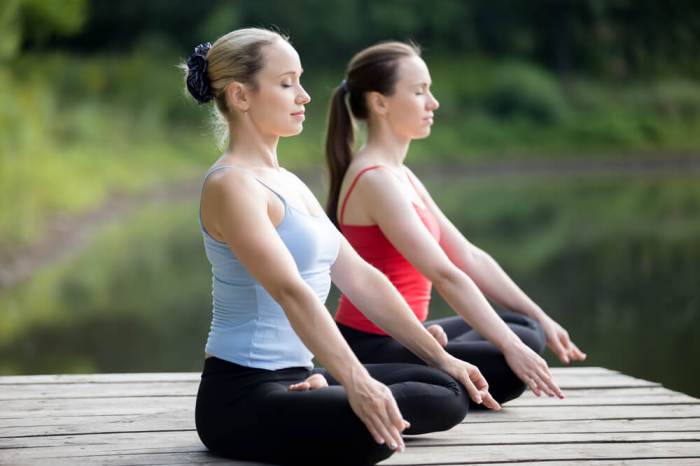
Stress reduction exercises offer a multitude of benefits that can enhance overall well-being and improve quality of life. By incorporating these practices into daily routines, individuals can experience positive changes in their physical, mental, and emotional health.
Improved Mood and Emotional Well-being
Stress reduction exercises can significantly improve mood and emotional well-being. These exercises work by promoting the release of endorphins, natural mood-boosting chemicals in the brain. Regular practice can lead to feelings of happiness, relaxation, and a greater sense of control over emotions.
Enhanced Cognitive Function and Concentration
Stress reduction exercises have a positive impact on cognitive function and concentration. By reducing stress levels, these exercises improve focus, attention span, and memory recall. They can also enhance creativity and problem-solving abilities.
Reduced Anxiety and Depression
Stress reduction exercises are effective in reducing anxiety and depression. By calming the nervous system and promoting relaxation, these exercises help manage symptoms of anxiety disorders and alleviate depressive feelings.
Improved Sleep Quality
Stress reduction exercises can improve sleep quality by promoting relaxation and reducing stress hormones. These exercises can help individuals fall asleep faster, sleep more soundly, and wake up feeling refreshed.
Increased Resilience to Stress
Regular practice of stress reduction exercises can increase resilience to stress. By building coping mechanisms and strengthening the body’s natural stress response system, these exercises enable individuals to handle stressful situations more effectively.
Applications of Stress Reduction Exercises
Stress reduction exercises have a wide range of applications in various contexts. These exercises can be effectively integrated into daily routines to manage stress and improve well-being.
Workplace Stress Management
Stress reduction exercises can be invaluable tools for managing workplace stress. Techniques such as deep breathing, meditation, and mindfulness can help employees cope with demanding work environments and reduce burnout.
Academic Stress Relief
Stress reduction exercises can effectively alleviate academic stress. Students can benefit from practices like yoga, progressive muscle relaxation, and visualization to manage exam anxiety, improve focus, and enhance academic performance.
Mental Health Conditions
Stress reduction exercises are often incorporated into treatment plans for various mental health conditions. These exercises can complement traditional therapies by promoting relaxation, reducing anxiety, and improving mood.
Challenges and Considerations
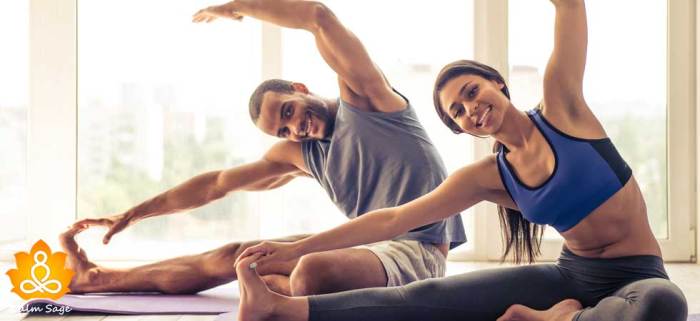
While stress reduction exercises offer numerous benefits, incorporating them into daily life can present certain challenges. It’s essential to understand these obstacles and develop strategies to overcome them to maximize the effectiveness of these practices.
Lack of Time and Motivation
Time constraints and a lack of motivation are common barriers to engaging in stress reduction exercises. Finding time for these activities can be difficult, especially for individuals with busy schedules. Additionally, the initial effort required to develop a routine and maintain consistency can be discouraging, leading to a lack of motivation.
- Prioritize and Schedule: Treat stress reduction exercises like any other important appointment. Schedule them into your calendar and prioritize them, just as you would a work meeting or a doctor’s appointment.
- Start Small: Begin with short, manageable sessions, even just a few minutes each day. As you build consistency, you can gradually increase the duration and frequency.
- Find Joy in the Process: Experiment with different exercises until you find ones that you genuinely enjoy. This will make it easier to stay motivated and look forward to your sessions.
Difficulty in Finding the Right Exercises
With a wide array of stress reduction exercises available, finding the right ones that resonate with your individual needs and preferences can be overwhelming. Some exercises might not be suitable for certain health conditions or may require specialized equipment or guidance.
- Explore Different Options: Research and try out various stress reduction techniques, such as mindfulness meditation, deep breathing exercises, yoga, tai chi, or progressive muscle relaxation.
- Seek Professional Guidance: Consider consulting a qualified healthcare professional, such as a therapist, counselor, or certified yoga instructor, for personalized recommendations and support in choosing the right exercises.
- Experiment and Adapt: Be open to trying different approaches and adapting exercises to suit your preferences and limitations.
Underlying Mental Health Conditions
Individuals with underlying mental health conditions may find it challenging to engage in stress reduction exercises effectively. Anxiety, depression, or other conditions can interfere with their ability to focus, relax, or even initiate these practices.
- Seek Professional Help: If you are struggling with a mental health condition, it is crucial to seek professional help from a qualified mental health professional. They can provide appropriate treatment and support to manage your condition and improve your ability to benefit from stress reduction exercises.
- Start with Simple Techniques: Begin with simple exercises that are easy to learn and practice, such as deep breathing or mindfulness exercises. Gradually introduce more complex techniques as you feel more comfortable.
- Be Patient and Kind to Yourself: Understand that progress may be gradual, and there may be setbacks along the way. Be patient with yourself and celebrate your successes, no matter how small they may seem.
Resources and Support
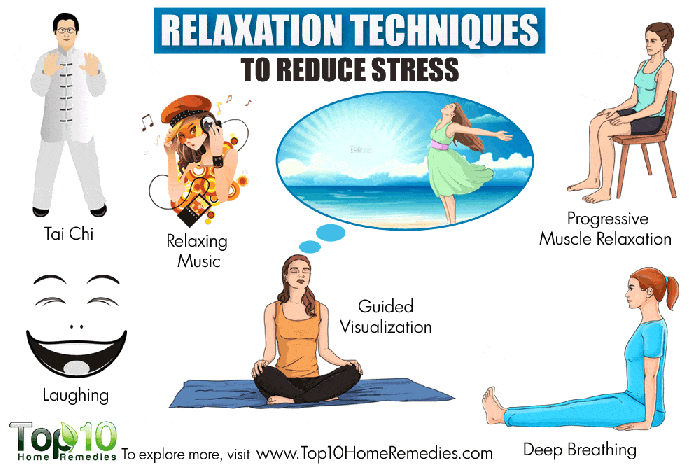
Embarking on a stress reduction journey is a personal commitment, and there are numerous resources available to guide and support you. This section explores various avenues to enhance your knowledge and access professional assistance.
Websites, Apps, and Online Courses
The digital landscape offers a wealth of information and interactive tools for stress management. Websites dedicated to mental well-being, mindfulness apps, and online courses provide structured guidance and practical exercises.
- Websites: Many reputable websites offer articles, blog posts, and resources on stress reduction techniques. Some popular options include the American Psychological Association (APA), the National Institute of Mental Health (NIMH), and the Mayo Clinic.
- Apps: Mindfulness apps like Headspace, Calm, and Insight Timer offer guided meditations, breathing exercises, and sleep-enhancing techniques. These apps are designed for convenience and accessibility, allowing you to practice stress reduction techniques anytime, anywhere.
- Online Courses: Online platforms like Coursera, edX, and Udemy offer courses on stress management, mindfulness, and related topics. These courses provide in-depth knowledge, and practical skills, and often include interactive exercises and community forums.
Books and Articles
For a deeper dive into stress reduction, books and articles provide comprehensive insights and evidence-based strategies.
- Books: Numerous books explore various aspects of stress management, including mindfulness, cognitive-behavioral therapy (CBT), and relaxation techniques. Some notable titles include “Mindfulness for Beginners” by Jon Kabat-Zinn, “The Happiness Project” by Gretchen Rubin, and “The Relaxation Response” by Herbert Benson.
- Articles: Scientific journals, health magazines, and online publications often feature articles on stress reduction, offering research findings, practical tips, and expert perspectives.
Local Organizations and Support Groups
Connecting with local organizations and support groups can provide a sense of community and access to resources tailored to your needs.
- Community Centers: Many community centers offer stress management workshops, yoga classes, and support groups focused on mental health.
- Support Groups: Joining a support group for stress or anxiety can offer a safe space to share experiences, receive peer support, and learn coping mechanisms from others who understand your challenges.
Finding Qualified Professionals
Seeking guidance from qualified professionals can be invaluable in developing personalized stress reduction strategies.
- Therapists: Therapists specializing in stress management, such as licensed clinical social workers (LCSWs), psychologists, or counselors, can provide evidence-based interventions and support.
- Doctors: Your primary care physician can offer initial guidance and refer you to specialists if needed.
- Online Directories: Websites like Psychology Today and the American Psychological Association (APA) provide directories of mental health professionals in your area.
Ending Remarks
Stress reduction exercises are not just a temporary fix; they are a lifelong investment in well-being. By embracing these practices, we can navigate the complexities of modern life with greater ease and cultivate a more balanced and fulfilling existence. Whether it’s finding a moment of stillness through meditation or engaging in a vigorous workout, the journey to stress reduction begins with a commitment to prioritizing our mental and physical health.
Comments are closed.